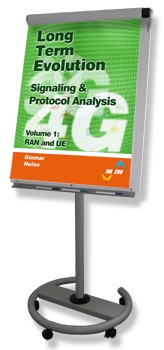 LTE - Signaling & Protocol Analysis
LTE - Signaling & Protocol Analysis
(Vol.1 RAN and UE)
[3-day training course, Euro 3,450.- per participant]
 Training Course Description
Training Course Description

- This training course is a must for everybody who requires a detailed understanding of the protocols and signaling procedures within E-UTRAN and the EPC. In that respect the clear focus of this course is on the protocols of the UE and the E-UTRAN.
- The training course starts with a review of the LTE physical layer and the concepts and protocol stacks of E-UTRAN. This part concludes with the review of the EPS network architecture.
- Immediately afterwards we jump into real-life call flows and scenarios and confront the student with the look & feel of the LTE protocol suite. This part ends with an assessment of what will be the focus of the following chapters.
- The next chapters are dedicated to the different protocols EMM, ESM, MAC, RLC, RRC, S1-AP, X2-AP, SGs-AP and S101-AP.
- The training course concludes with the presentation and analysis of LTE signaling flows and real-life call flows.
As in all our training courses, we integrated several interactive exercises for a perfect learning experience.
Some of your questions that will be answered
- How do attachment, session establishment and bearer setup work in LTE?
- How does a circuit-switched fallback scenario look and which messages are exchanged among which network nodes when and why?
- Can I obtain an e2e-scenario that explains how the PCRF authorizes and initiates a dedicated EPS-bearer establishment?
- How are the LTE protocol stack entities organized and which channels are established between them?
- How do the PDU's of MAC, PLC, PDCP, RRC, S1-AP and the X2-AP look like?
- According to which guidelines MAC is scheduling the traffic and how is the flow control in between UE and eNodeB performed?
- What are the benefits of multiplexing logical channels on transport blocks and to apply a flexible RLC PDU size?
- What new security concepts are applied in PDCP?
- What are the key differences of RRC in E-UTRAN vs RRC in UTRAN?
- How do we interpret ASN.1 PER encoded call flows like in RRC and in S1-AP?
- How the concept of the initial context setup procedure s allowing for a very low control plane latency?
- How are system information messages structured and transmitted in LTE?
- How is the interworking with cdma2000 embedded and realized in LTE?
- What are the mechanisms to create a self-organizing network?
- How do the various handover scenarios in LTE work?
 Who should attend this class?
Who should attend this class?
- Test engineers who need to understand the details of the LTE signaling protocols.
- Design staff of handsets and E-UTRAN who requires a deep inside view of the LTE-related protocols.
- 2nd and 3rd level troubleshooters who need to understand the LTE protocol stack in detail.
 Pre-Requisites
Pre-Requisites
- The student must possess a thorough understanding of LTE and EPS before coming to this course.
- We recommend our courses LTE from A-Z and SAE from A-Z to be taken beforehand.
- Practical experience with protocol testers and IP-sniffers is necessary.
 Training Course Target
Training Course Target
- The student is enabled to understand the concepts of the LTE protocol stack.
- The student is able to develop and to test the higher layer protocol stack of LTE.
- The student will be enabled to effectively communicate LTE protocol stack issues with his/her peers.
 Training Course Duration
Training Course Duration
- 3 days
v1.000
ℹ️ Try out the updated search below!
Search:
More Info:
Detailed ToC of this training course
Schedule of this training course
Buy this book
Buy this book as eBook
INACON eBooks
Please have a look at our full offer

